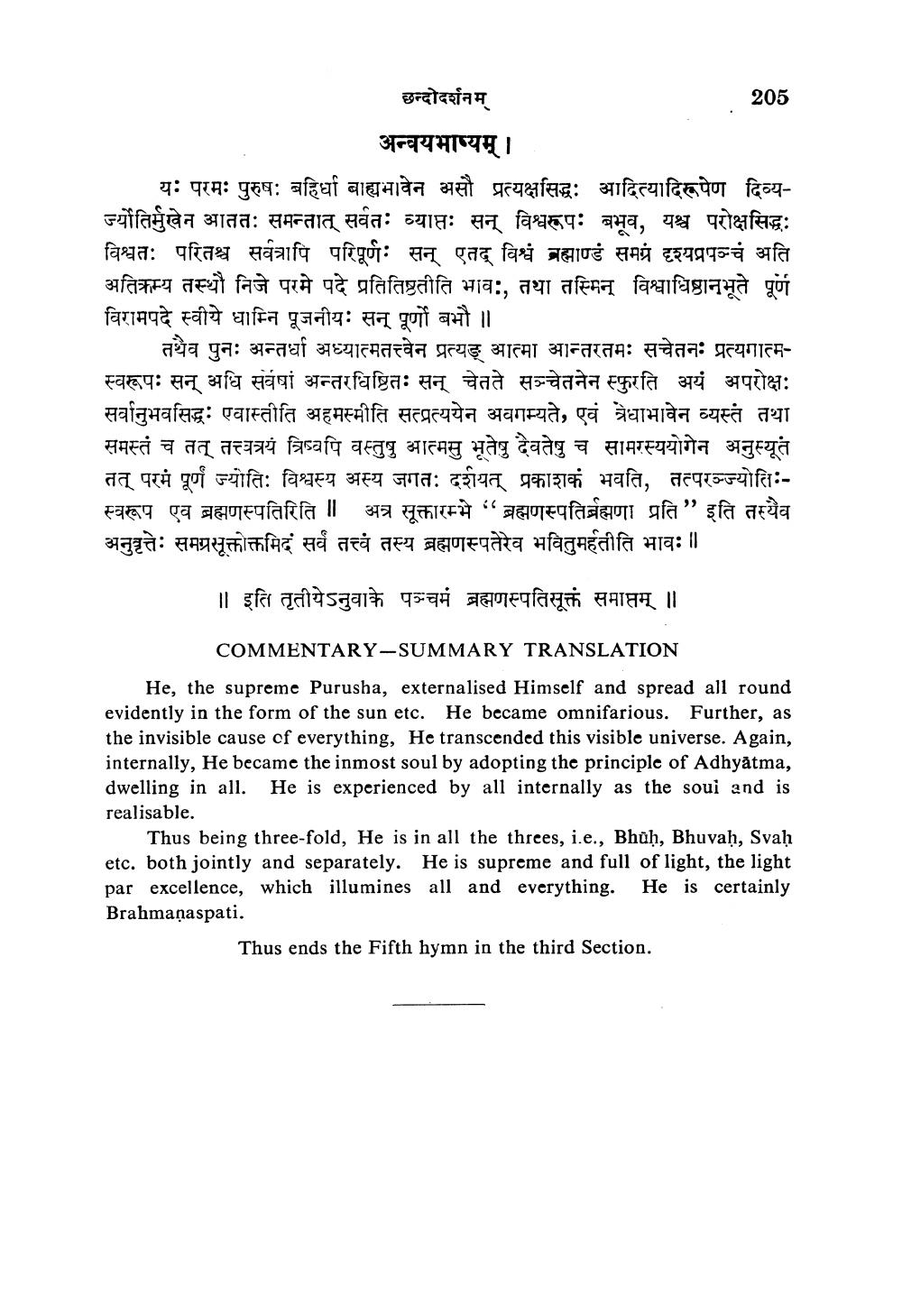________________
छन्दोदर्शनम्
अन्वयभाष्यम् ।
यः परमः पुरुषः बहिर्धा बाह्यभावेन असौ प्रत्यक्षसिद्ध: आदित्यादिरूपेण दिव्यज्र्ज्योतिर्मुखेन आततः समन्तात् सर्वतः व्याप्तः सन् विश्वरूपः बभूव, यश्च परोक्षसिद्धः विश्वतः परितश्च सर्वत्रापि परिपूर्णः सन् एतद् विश्वं ब्रह्माण्डं समग्रं दृश्यप्रपञ्चं अति अतिक्रम्य तस्थौ निजे परमे पदे प्रतितिष्ठतीति भाव:, तथा तस्मिन् विश्वाधिष्ठानभूते पूर्ण विरामपदे स्वीये धाम्नि पूजनीयः सन् पूर्णो बभौ ॥
तथैव पुनः अन्तर्धा अध्यात्मतत्त्वेन प्रत्यङ् आत्मा आन्तरतमः सचेतनः प्रत्यगात्मस्वरूपः सन् अधि सर्वषां अन्तरधिष्ठितः सन् चेतते सञ्चेतनेन स्फुरति अयं अपरोक्षः सर्वानुभवसिद्धः एवास्तीति अहमस्मीति सत्प्रत्ययेन अवगम्यते, एवं त्रेधाभावेन व्यस्तं तथा समस्तं च तत् तत्त्वत्रयं त्रिष्वपि वस्तुषु आत्मसु भूतेषु दैवतेषु च सामरस्ययोगेन अनुस्यूत तत् परमं पूर्णं ज्योतिः विश्वस्य अस्य जगतः दर्शयत् प्रकाशकं भवति, तत्परञ्ज्योतिःस्वरूप एव ब्रह्मणस्पतिरिति ॥ अत्र सूक्तारम्भे " ब्रह्मणस्पतिर्ब्रह्मणा प्रति" इति तस्यैव अनुवृत्तेः समग्रसूक्तोक्तमिदं सर्वं तत्त्वं तस्य ब्रह्मणस्पतेरेव भवितुमर्हतीति भावः ॥
॥ इति तृतीयेऽनुवाके पञ्चमं ब्रह्मणस्पतिसूक्तं समाप्तम् ॥
205
COMMENTARY-SUMMARY TRANSLATION
He, the supreme Purusha, externalised Himself and spread all round evidently in the form of the sun etc. He became omnifarious. Further, as the invisible cause of everything, He transcended this visible universe. Again, internally, He became the inmost soul by adopting the principle of Adhyatma, dwelling in all. He is experienced by all internally as the soui and is
realisable.
Thus being three-fold, He is in all the threes, ie, Bhūh, Bhuvah, Svah etc. both jointly and separately. He is supreme and full of light, the light par excellence, which illumines all and everything. He is certainly Brahmanaspati.
Thus ends the Fifth hymn in the third Section.




